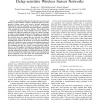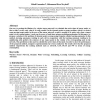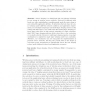200 search results - page 26 / 40 » Worst-case lifetime computation of a wireless sensor network... |
SAC
2009
ACM
14 years 2 months ago
2009
ACM
This paper proposes 2G, a flexible and energy-efficient data collection protocol for sensor networks for increasing network lifetime. To this end, it integrates self-organizing d...
MOBIWAC
2006
ACM
14 years 1 months ago
2006
ACM
In wireless sensor networks data propagation is usually performed by sensors transmitting data towards a static control center (sink). Inspired by important applications (mostly r...
GLOBECOM
2008
IEEE
14 years 2 months ago
2008
IEEE
—Immediate notification of urgent but rare events and delivery of time sensitive actuation commands appear in many practical wireless sensor and actuator network applications. M...
AHSWN
2010
13 years 7 months ago
2010
One way to prolong the lifetime of a wireless sensor network is to schedule the active times of sensor nodes, so that a node is active only when it is really needed. In the dynami...
EWSN
2009
Springer
14 years 8 months ago
2009
Springer
Sensor sleeping is a widely-used and cost-effective technique to save energy in wireless sensor networks. Protocols at different stack levels can, either individually or simultaneo...



